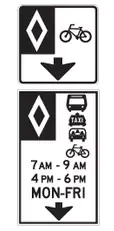Reserved Lane Sign
-
 CDE
CDE - Update on. 23 Apr, 2025

Introduction
The Reserved Lane sign is a regulatory road sign found on many urban roads and highways in Canada, particularly in Ontario. It designates a lane reserved for specific vehicles, such as buses, taxis, bicycles, and high-occupancy vehicles (HOVs), during certain times. Knowing how to interpret this sign is important for all drivers and is part of the Ontario G1 driving test syllabus.
What Does the Reserved Lane Sign Mean?
This sign typically includes:
-
A white diamond symbol on a black background indicating a reserved lane
-
Arrows showing the lane’s direction or position
-
Icons of permitted vehicles (e.g., bus, bicycle, taxi, carpool)
-
Time and day restrictions, often listed below the icons
In this case:
-
The lane is reserved Monday to Friday, 7–9 AM and 4–6 PM
-
Only buses, taxis, bicycles, and carpool (HOV) vehicles may use the lane during those hours
Where Are These Signs Placed?
Reserved lane signs are found:
-
On urban roads or highways with designated lanes
-
Near downtown cores or transit routes
-
On curb lanes often used by buses and bikes during rush hours
-
Along routes prone to congestion to manage traffic more efficiently
How Should Drivers Respond to This Sign?
Drivers should:
-
Avoid entering the reserved lane during restricted times unless driving an allowed vehicle
-
Merge into adjacent lanes before entering the restricted area
-
Use the lane only outside the specified times if they are not driving a permitted vehicle
-
Understand this rule is enforced with fines and sometimes monitored via cameras
Visual Representation of the Sign
-
Top panel: diamond symbol with a bicycle and a down arrow
-
Bottom panel: diamond symbol, icons for bus, taxi, bike, and carpool
-
Time window: 7:00–9:00 AM and 4:00–6:00 PM, Monday to Friday
Conclusion
The Reserved Lane sign helps streamline traffic for public transit, cyclists, and carpoolers during peak hours. For everyday drivers, understanding and obeying this sign is key to avoiding fines and ensuring safe, legal road use. For new drivers preparing for their Ontario G1 test, this is a must-know traffic regulation that supports smoother commuting in busy areas.

Please Comment Below